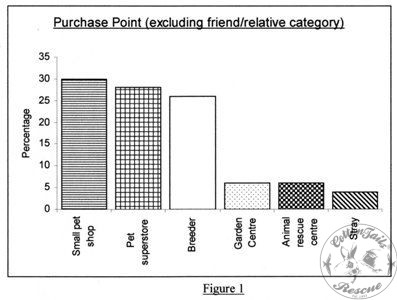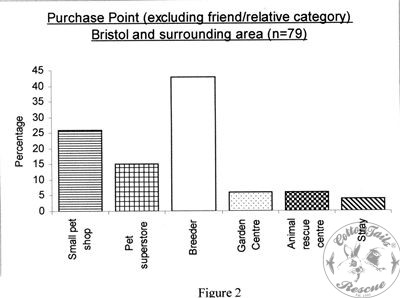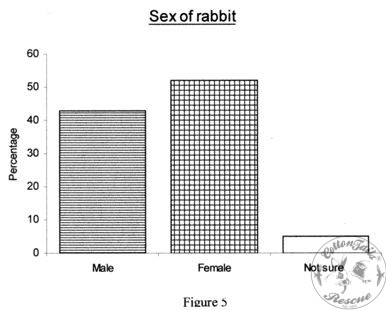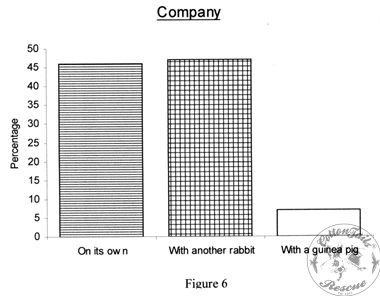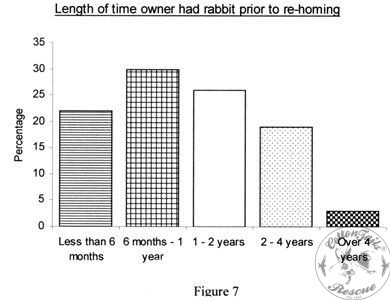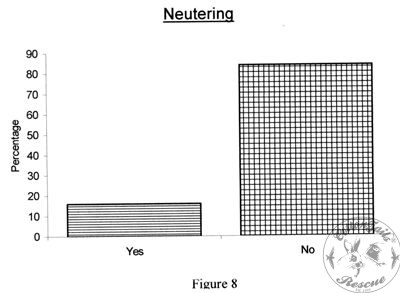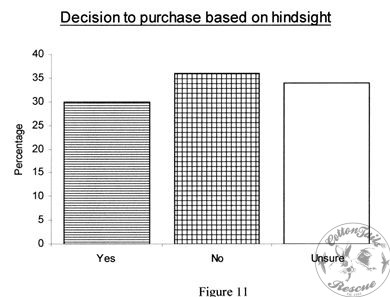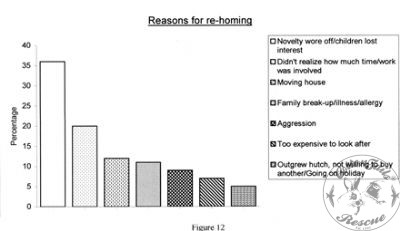Despite all our endeavours to educate and inform the rabbit-buying public to think twice before purchasing a pet, thousands are still dumped every year.
My aim in creating and carrying out this study was to produce hard facts that could be utilised to target, lobby and encourage the primary sources of purchase to take a more responsible attitude to the ever-increasing problem of unwanted pet rabbits. Although the study was carried out some years ago, it compares very accurately to more recent similar surveys by various animal welfare organisations. Hence, the findings are still relevant today. Nothing has changed in the intervening years, which is quite discouraging.
In the six months that the survey was carried out (August 2001 to the end of January 2002), I received over 450 completed questionnaires. Although this would appear to be a small number compared to the thousands of rabbits taken in annually, this can be partially explained by the fact that the majority of rabbits taken in by many rescue centres are strays, and therefore, no background data would be collected. Furthermore, the high percentage of rabbits passed from one home to another before finally ending up in a rescue centre often makes it impossible to determine where the rabbit came from in the first place.
Sufficient areas of the UK were covered via the responses to make the results apply nationally, except Scotland, where, disappointingly, only one private rescue took part in the study. Regional variations were apparent in the “Purchase Point” category, all other categories being consistent throughout the country.
Unplanned litters due to accidental encounters or wrong sexing were discounted from the study, as were stray rabbits that were handed into centres almost immediately upon finding them. Strays that the finder had kept for at least six months, however, were included.
RESULTS
Purchase Point
Over a quarter of all rabbits handed into rescue centres had already had at least two previous homes (friend/relative/neighbour). Unfortunately, there was no way of finding where these rabbits were initially purchased, so this figure was excluded from the total.
There was no significant difference between rabbits supplied by breeders, small pet shops, or pet superstores, supplying over 80% of the rabbits between them (Figure 1). If you combine the pet shop totals, it is apparent that almost 60% of rabbits came from this source alone, just under 30% from breeders, and about 10% split evenly between animal rescue centres, garden centres, or strays. There were some interesting regional differences. For example, Bristol and surrounding areas (Figure 2) showed that most rabbits (43%) came from breeders alone, compared with 41% of the combined total from pet shops.
Purchase Price
Most rabbits (32%) were obtained for free, reflecting the high percentage of rabbits passed on by friends/relatives/neighbours. Excluding this category, of the people who paid for their rabbits, I found that the majority paid between £10-£20 per rabbit (57%), the remainder being equally divided between under £10 or over £20 (Figure 3).
Who the rabbit was bought for
Although, as expected, most rabbits were bought for children, a surprisingly large percentage (40%) were bought by adults for adults (Figure 4).
Sexes
More female than male rabbits were placed for adoption, but the difference of 9% was relatively small, with 5% of contributors not being sure of the rabbit’s sex (Figure 5).
Company
Equal numbers of rabbits were bought to stay on their own as were to live with another rabbit. Few (7%) were bought to live with guinea pigs (Figure 6).
How long the rabbit was kept before re-homing
As can be seen from Figure 7, most rabbits were re-homed after just six months to 1 year (30%), followed by 1-2 years (26%), less than six months (22%), and 2-4 years (19%). Very few were given up after four years (3%).
Neutering
Only 16% of rabbits were neutered before they arrived at rescue centres (Figure 8).
Vaccinations
80% were not vaccinated before admission, with VHD and myxomatosis vaccination equally divided among the remainder (Figure 9). Of the rabbits immunised, few were given VHD and myxomatosis injections, most being given either one or the other.
Information at the point of purchase
Most people (60%) felt that the information given at the time of purchase was poor or non-existent. Only 16% felt the information was good, the remaining 24% deciding it was adequate (Figure 10).
Decision based on hindsight
Figure 11 shows there was surprisingly little difference between the “wouldn’t have taken it on” (36%) and those that were “unsure” (34%). 30% said they would have taken on the rabbit even if the potential problems had been pointed out.
Reasons given for re-homing
The most typical reason for re-homing was “children lost interest” and “novelty wore off” (36%). Ignorance came next: “didn’t know how much time/work was involved” (20%). The remaining categories were evenly distributed at about 10% each: aggression; moving house; too expensive to keep; family break-up or illness/allergy; Going on holiday or “outgrown hutch, not willing to buy another” contributed another 5% (Figure 12).
Comments
Contributors were invited to make suggestions or comments that would be helpful to potential purchasers of rabbits, and these comments are summarised below.
- “they need company”
- “don’t buy until you find out about them”
- “temperament is important – rabbits can be unpredictable”
- “they can smell”
- “need plenty of time and commitment”
- “not as easy or cheap to look after as I thought”
- “make sure you can find homes for babies before breeding”
- “I didn’t know how quickly they could breed”
- “don’t give them as a surprise gift”
- “vet fees are expensive”
- “consider pet insurance”
- “rabbits and guinea pigs don’t get on”
- “they aren’t cuddly”
- “they must have space to run”
- “be aware of teeth problems”
- “too easy to get”
- “rabbits grow big”
- “find out about the size of hutch and run needed”
- “it is really unpleasant to clean out in the winter weather”
- “get the sexing double checked”
Conclusions
There were some surprises in the results, but mostly, they confirmed what we already suspected.
Purchase Point Not surprisingly, pet shops are the primary source of where people purchase rabbits. Still, the numbers being purchased directly from breeders show that they must not be complacent about their contribution to the unwanted rabbit problem. This is especially apparent in some regions of the country, such as Bristol, where far more unwanted rabbits were initially purchased from breeders than the combined total from pet shops. It was reassuring to see that relatively few rabbits were re-homed after having come from rescue centres, the same being true also for Garden Centres. However, this may only reflect the relatively small numbers sold compared to the vast numbers supplied by pet shops and breeders.
Purchase Price It would appear that whether the rabbit was free or cost £20 or more had little effect on the decision to give the pet away.
Who the rabbit was purchased for It was surprising to see how many rabbits were bought by adults for adults. This indicates that it is not just the children who get bored with their pets!
Sexes Almost equal numbers of males versus females reflect my findings at CottonTails Rescue. This indicates that the often-observed moodiness of female rabbits is not necessarily the only factor in the decision to off-load a rabbit.
Company It is reassuring that few rabbits were purchased to live with guinea pigs, and most of those that were had to be separated due to incompatibility. The number of rabbits bought to live with others compared equally with those purchased to live on their own. From the amount bought to live solitary lives, we must conclude that we still have a long way to go to persuade the public about the advantages of rabbits living in compatible neutered pairs.
How long was the rabbit kept before re-homing The results again reflected my findings here at CottonTails, as it is a common occurrence that many baby rabbits bought especially at Easter are discarded again during the winter months (i.e.6 months to 1 year after purchase), coinciding with a wane of interest.
Neutering Vet fees, lack of knowledge and apathy are primarily to blame for the 84% of rabbits arriving at rescue centres un-neutered. This is giving a clear message to us all (including vets) that we must try harder to inform the public of the advantages that neutering brings to their rabbits and, ultimately, to themselves. Still, the high costs will continue to be a significant problem for many rabbit owners and rescue centres.
Vaccinations Again, apathy, lack of knowledge and vet fees were the main reasons for 80% of rabbits being un-vaccinated. The sense of rabbits being a cheap, disposable pet is still very strong in most of the population. Therefore, spending upwards of £70 or more per rabbit annually for both vaccinations is just not considered viable.
Information Good advice at the time of purchase is clearly and sadly lacking, and this may be a crucial factor in why so many rabbits are discarded.
Hindsight A surprisingly high percentage of people stated they would still have taken on their pet at the beginning even if they had been warned about the potential problems. Does this mean that they might repeat the same mistake in future?
Reasons The results here were fairly predictable and reflected in the “comments” section.
End Summary
In conclusion, there is still a vast amount of work to be done to get the right message across to the public. This can only be done by working with pet shops and breeders to educate and inform rather than alienating them against rabbit rescue and the massive unwanted rabbit population problem. It seems unlikely that there will be any laws in the future banning the sale of rabbits in pet shops, but even if there were, it can be seen clearly from the results that breeders are also responsible for supplying large numbers that end up unwanted, too.
Addressing two significant issues may ultimately help to reduce the unwanted rabbit population: marketing – the impression that rabbits make ideal children’s pets must be stamped out completely, and a more realistic and knowledgeable approach adopted in its place; sexing – correct sexing of very young rabbits can be difficult, so it is unfair to expect all pet shop staff to be expert in this field, and short of demanding that all rabbits are sexed by experienced vets before being sold, I can see no obvious solution to this particular problem.
If rabbits were not so appealing, we wouldn’t have this unhappy situation, but who can blame any of us for falling for these delightful and rewarding creatures? After all, Peter, Brer, Flopsy, and Mopsy have much to answer for!


